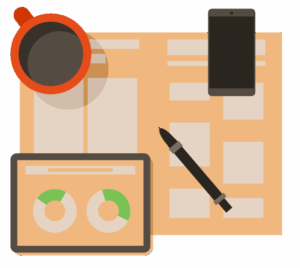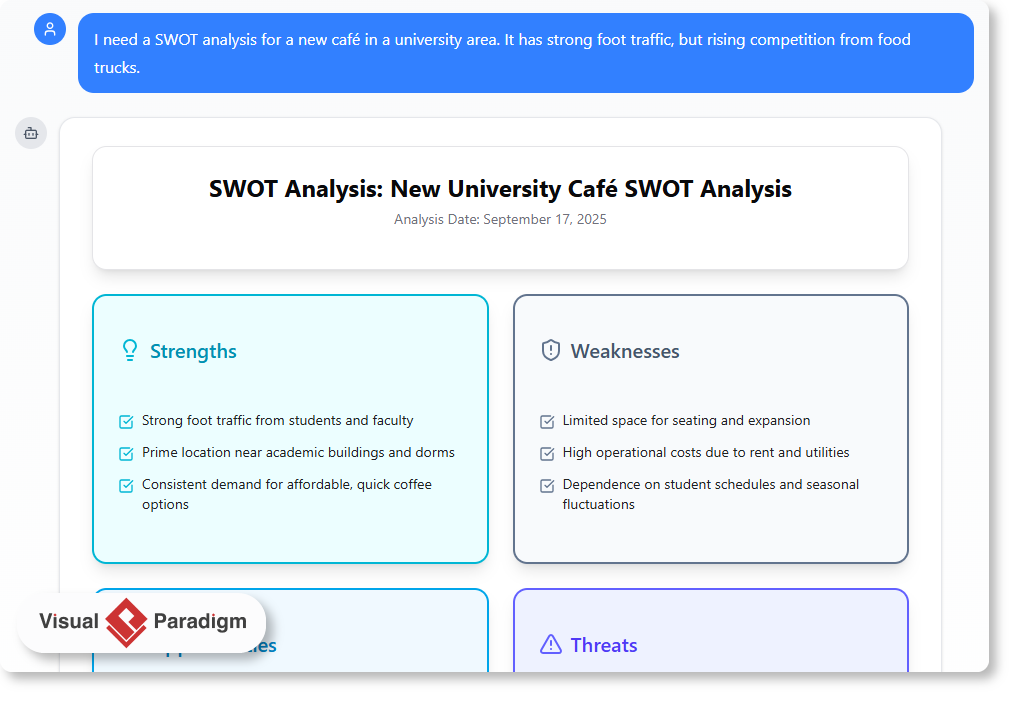Now Reading: Why the Right Diagram Type Matters in Business Strategy
-
01
Why the Right Diagram Type Matters in Business Strategy
Why the Right Diagram Type Matters in Business Strategy

In strategic planning, decisions are often made after understanding the bigger picture. Whether you’re assessing market risks, mapping internal workflows, or evaluating business opportunities, having the right visual tool makes a tangible difference. The key isn’t just to create diagrams—it’s to choose the right one for the situation. That’s where diagram types come into play.

Different diagram types are designed to serve specific business needs. A SWOT analysis helps teams understand internal strengths and external threats. A use case diagram reveals how users interact with a system. An ArchiMate view maps enterprise architecture across domains. Choosing the wrong one leads to confusion, misalignment, and wasted time. The right diagram, used in the right context, supports faster decisions and better outcomes.
This isn’t just about visuals—it’s about efficiency. In fast-moving environments, teams need to generate insights quickly. That’s where AI-powered diagramming steps in. With an ai chatbot for modeling, teams can now describe a situation in plain language and generate accurate diagrams from text. This eliminates the time spent manually designing shapes, connections, and labels.
Common Diagram Types and Their Strategic Use Cases
Business decisions rely on clear, structured representations. Here’s a breakdown of key diagram types and when they deliver real value.
| Diagram Type | Best For | Example Use Case |
|---|---|---|
| UML Use Case Diagram | Understanding user interactions | Mapping how customers engage with a banking app |
| SWOT Analysis | Evaluating a business opportunity | Assessing a new product launch in a competitive market |
| PESTEL or PESTLE | Market environment analysis | Identifying regulatory risks for a global retail operation |
| C4 Diagrams | System architecture planning | Defining the context of a cloud-based e-commerce platform |
| SysML Requirement Diagram | Capturing functional needs | Aligning software features with customer requirements |
| ArchiMate View | Enterprise architecture planning | Aligning business units with IT infrastructure |
| Eisenhower Matrix | Prioritizing tasks | Planning a product roadmap with limited resources |

Each of these diagram types supports a specific phase of strategic work. For instance, a product owner launching a new service might start with a SWOT to assess internal capabilities and external pressures. Then, they’d use a use case diagram to outline key user journeys. Later, they might leverage a C4 context diagram to understand dependencies and stakeholders.
The challenge, however, is knowing which one to pick—and how to create it efficiently. This is where the ai diagram generator shines.
How an AI Chatbot for Modeling Accelerates Decision-Making
Traditional diagramming requires time, expertise, and repeated trial and error. A skilled modeler might spend hours refining a sequence diagram to match business logic. That’s not just inefficient—it delays strategic action.
An ai chatbot for modeling changes that dynamic. Instead of drawing lines and shapes, a team member can simply describe the scenario in natural language. For example:
“I need a SWOT analysis for a new café in a university area. It has strong foot traffic, but rising competition from food trucks.”
The ai chatbot interprets this input and generates a clear, professional SWOT diagram—complete with strengths, weaknesses, opportunities, and threats—within seconds.

This capability supports natural language diagram generation. The tool doesn’t just produce shapes—it understands context. It recognizes that “strong foot traffic” is a strength and “rising competition” is a threat. It then structures the diagram logically, aligning with standard business frameworks.
This isn’t just about speed. It’s about consistency. Every team member, regardless of modeling experience, can produce a suitable diagram for the situation. That ensures alignment across departments and reduces the risk of miscommunication.
In a project with tight timelines, this can cut analysis time by up to 70%. The team doesn’t spend days building a model—they focus on strategy, innovation, and execution.
Real-World Application: From Market Insight to System Design
Let’s walk through a realistic scenario.
A digital health startup is launching a new telemedicine platform. The product team needs to understand how patients will use the service, identify risks, and map the system architecture.
The process unfolds this way:
- Market Assessment: The founder describes the market: “We’re entering a region with high patient expectations and growing mobile health adoption. But there’s strong competition from existing platforms.”
→ The ai chatbot generates a PESTLE analysis, identifying regulatory, technological, and social factors. - User Journey: A UX lead asks: “Show me a use case diagram for patients accessing the platform.”
→ The ai chatbot produces a clear UML use case diagram showing patient roles, login, appointment booking, and consultation. - System Design: The engineering lead says: “I need a C4 system context diagram to show how the platform connects with hospital networks.”
→ The ai chatbot creates a clean C4 system context with stakeholders, boundaries, and dependencies.
Each step uses the right diagram type for the situation. No manual drawing. No confusion. Just clear, actionable visuals.
This workflow is scalable. It works for startups, mid-sized firms, and established enterprises. It doesn’t require modeling expertise. It requires only clear communication.
What Makes Visual Paradigm the Leading AI-Powered Modeling Solution?
The combination of accurate diagram types and intelligent ai-powered diagramming sets this tool apart. Unlike basic diagram tools that rely on templates, the ai chatbot for modeling understands strategic context. It can generate diagrams from text and adapt to specific modeling standards—UML, SysML, ArchiMate, C4, and business frameworks like SWOT or Ansoff.
This functionality enables teams to focus on strategy, not syntax. It supports natural language diagram generation, making the tool accessible to non-technical stakeholders. The output is not just visual—it’s contextual, interpretable, and ready for discussion.
When a team can generate a suitable diagram for a situation in minutes instead of hours, they gain a competitive edge. They move faster. They make better decisions. They reduce risk.
For organizations that rely on visual thinking to drive innovation, this is not a convenience—it’s a strategic asset.
Frequently Asked Questions
Q: What diagram types are supported by the ai chatbot for modeling?
A: The ai chatbot supports common diagrams used in business and systems design, including UML, SysML, C4, ArchiMate, SWOT, PESTLE, and business frameworks like the Eisenhower Matrix and Ansoff Matrix.
Q: When should I use an ai diagram generator instead of hand-drawing?
A: Use it when you need to quickly generate a suitable diagram for a situation—especially when you have a clear textual description of the scenario.
Q: Can I generate diagrams from text with the ai chatbot?
A: Yes. Simply describe your situation in natural language. The ai chatbot will interpret the input and generate a relevant diagram with accurate structure and labels.
Q: Is the ai-powered diagramming feature available to all users?
A: Yes. The ai chatbot for modeling is accessible to all users and works across all supported diagram types.
Q: How does the ai chatbot ensure accuracy in diagram generation?
A: The ai is trained on established modeling standards and business frameworks. It generates diagrams based on recognized patterns and best practices, ensuring the output aligns with industry norms.
Q: Can I refine a diagram after it’s generated?
A: Yes. The ai chatbot allows users to request changes—such as adding elements, renaming components, or refining structure—making the output adaptable to evolving needs.
For more advanced diagramming capabilities, check out the full suite of tools available on the Visual Paradigm website.
To get started with the ai chatbot for modeling and explore natural language diagram generation, visit https://chat.visual-paradigm.com/.




